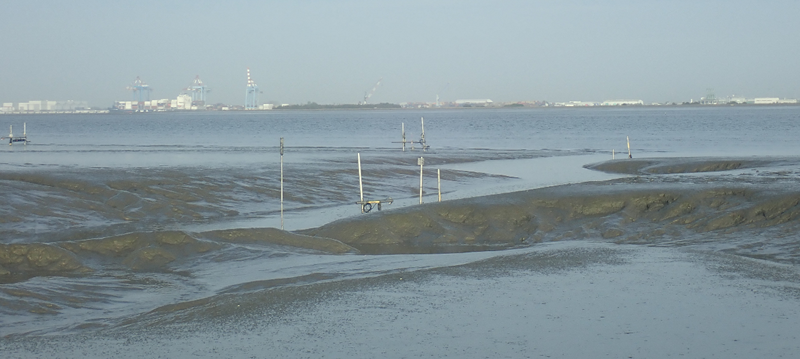J.L.J. Hanssen1,2*, Romaric Verney3, Florent Grasso3, P.M.J. Herman1,2, B.C. van Prooijen1,2
1 Delft University of Technology, Delft, The Netherlands; 2 Deltares, Delft, The Netherlands; 3 Ifremer, Brest, France.
*corresponding author:
Introduction
Tidal flats are heterogeneous landscapes with a variety of topographic features (bed forms). These bed forms influence the biotic and abiotic conditions of the tidal flat. Creeks are a specific bed form that cut through a tidal flat and are oriented perpendicular to the main channel (Figure 1). Previous measurements show that flow velocities in such a creek can be significant compared to the flow over the tidal flat. It is not known how creeks affect the hydrodynamic conditions and sediment transport of a flat and what the zone of influence is.
Methods
We measured the flow velocity, water levels, sediment concentration, bed composition and bed level in a creek and on the adjacent tidal flat in the Loire (France), during a one month field campaign. We placed 10 frames with instruments in, close to and at distance from the creek to cover the spatial variation.
Results
The measurements showed a clear distinction of the function of the creek between ebb and flood conditions. When the flat starts falling dry, the creek starts playing a more dominant role. The creek keeps discharging water even when the surrounding flats are virtually dry. Remaining water cannot flow over the tidal flat itself, but can only be discharged via the creek and connected smaller creeks. The creek discharges water with a flow velocity in the order of centimeters per second. Consequently, the duration of ebb flow in the creek is significantly longer than the duration of the flood flow. With this drainage function the creek affects the net sediment transport on the tidal flat (depending on the sediment concentration) and the dewatering of the bed material and its resulting strength.
The bed samples show that the grainsize becomes smaller towards the creek. This refining is more pronounced for a larger creek depth. This indicates that a creek can affect the bed composition in the adjacent region, depending on its depth.
Based on the measurements of this fieldwork, we can quantify the effect of a creek on the hydrodynamic conditions, sediment fluxes and bed composition of a tidal flat, which is crucial to understand the flat morphology and biotic conditions. This knowledge makes it possible to use creeks as an indicator for the morphological and ecological state of a tidal flat in estuarine management.

Figure 1: Frames with instruments placed in a creek and on the adjacent tidal flat in the Loire estuary.
I. Surname1*, F.N. Another-Surname2 , Y. Next-Surname2
1 University Name, Country; 2 Organization Name, Country
* Corresponding author: mail.name@organization.org


